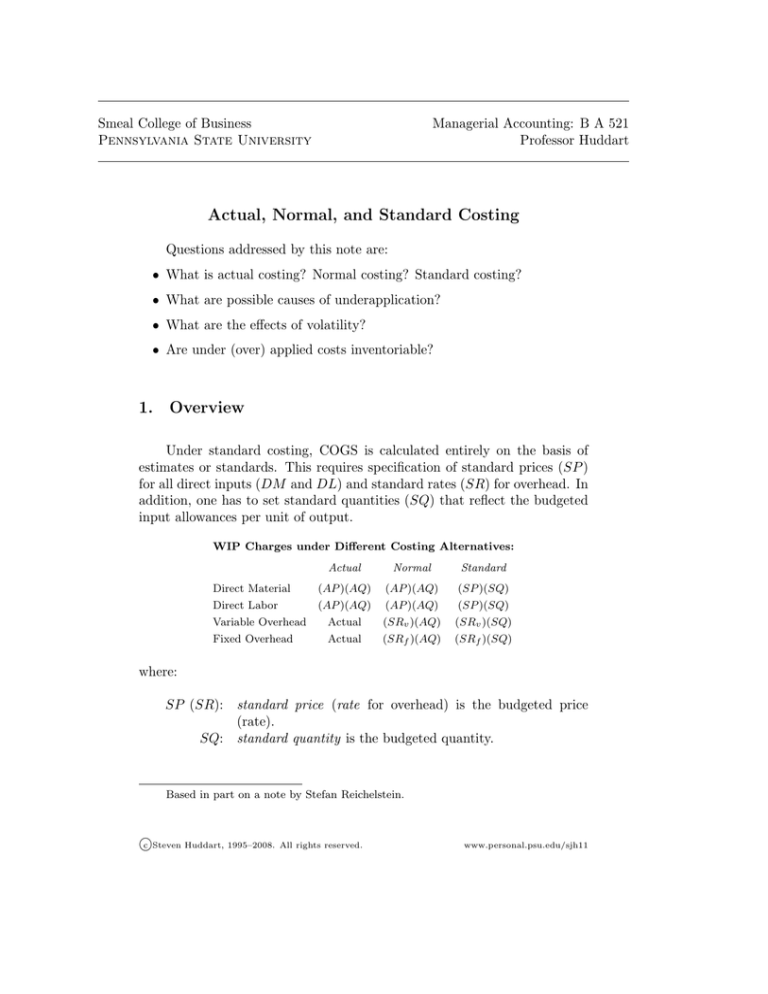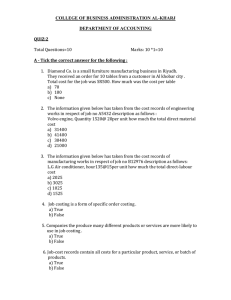
Smeal College of Business
Pennsylvania State University
Managerial Accounting: B A 521
Professor Huddart
Actual, Normal, and Standard Costing
Questions addressed by this note are:
• What is actual costing? Normal costing? Standard costing?
• What are possible causes of underapplication?
• What are the effects of volatility?
• Are under (over) applied costs inventoriable?
1.
Overview
Under standard costing, COGS is calculated entirely on the basis of
estimates or standards. This requires specification of standard prices (SP )
for all direct inputs (DM and DL) and standard rates (SR) for overhead. In
addition, one has to set standard quantities (SQ) that reflect the budgeted
input allowances per unit of output.
WIP Charges under Different Costing Alternatives:
Direct Material
Direct Labor
Variable Overhead
Fixed Overhead
Actual
Normal
Standard
(AP )(AQ)
(AP )(AQ)
Actual
Actual
(AP )(AQ)
(AP )(AQ)
(SRv )(AQ)
(SRf )(AQ)
(SP )(SQ)
(SP )(SQ)
(SRv )(SQ)
(SRf )(SQ)
where:
SP (SR): standard price (rate for overhead) is the budgeted price
(rate).
SQ: standard quantity is the budgeted quantity.
Based in part on a note by Stefan Reichelstein.
c Steven Huddart, 1995–2008.
All rights reserved.
www.personal.psu.edu/sjh11
B A 521
2.
Actual, Normal, and Standard Costing
Advantages of Standard Costing over Actual and Normal Costing
• Useful in the budgeting process.
• Corrects for temporary price changes.
• Corrects for temporary inefficiencies.
3.
Example of underapplication:
Volume
Costs
Estimated
Actual
100 units
$5,000
110 units
$6,000
• Application Rate $50/unit
• The ratio of estimated costs to volume differs from the ratio of actual
costs to volume.
Costs applied are $50/unit × 110 units
Costs incurred are
=
$5,500
$6,000
Underapplication of costs
500
• Similarly, costs can be overapplied.
4.
Seasonality Example—CPA Firm
A salaried staff person costs $50,000 and reports time at work of 2,000
hours.
• Naive model for costing jobs:
Application rate for staff person =
$50,000
= $25/hr
2,000 hours
• But staff person is only used intensively on chargeable client work from
January to June:
Jan – June
July – December
200 hours/month
100 hours/month
6 × 200
6 × 100
=
=
hours
1,200
600
1,800
100
100
Training
Unassigned
2,000
Page 2
Actual, Normal, and Standard Costing
B A 521
• Should a job in January be costed at the same amount as a job in July?
If so, does this lead to efficient resource allocation?
• When should training take place?
• What is the opportunity cost of training?
• Should you solicit work at $24/hr in January? In July?
• Should you solicit work at $28/hr in January? In July?
Page 3



